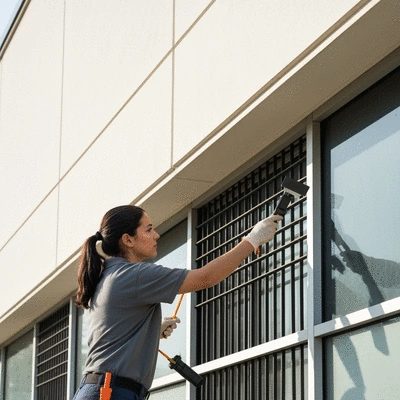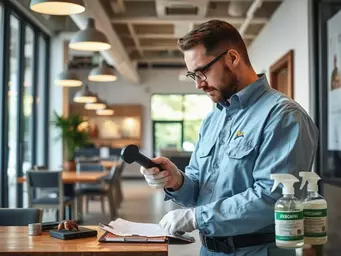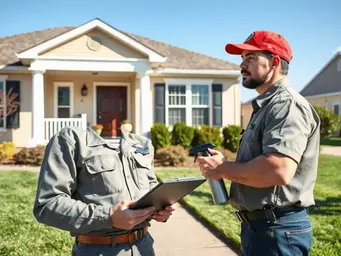In the competitive world of commercial pest control, understanding the intricate challenges businesses face can empower you to take proactive measures. This knowledge can be the key to maintaining a pest-free environment and ensuring the health of your operations.
What You Will Learn
- Recognize the impact of pest resistance and how it complicates control efforts.
- Understand the significance of regulatory compliance in pest management strategies.
- Learn the essential steps for accurate pest identification to ensure effective treatment.
- Explore Integrated Pest Management (IPM) strategies and eco-friendly solutions for pest control.
- Evaluate critical factors when choosing professional pest control services to protect your business.
- Discover the importance of monitoring techniques for early detection of pest activity.
Key Challenges and Solutions in Commercial Pest Control
Understanding the landscape of commercial pest control involves recognizing common challenges and implementing effective solutions. This visual outlines these critical aspects.
Key Challenges
- ✓ Pest resistance to treatments
- ✓ Invasive species adaptation
- ✓ Regulatory compliance
- ✓ Accurate identification
Effective Solutions
- ✓ Integrated Pest Management (IPM)
- ✓ Eco-friendly treatments
- ✓ Advanced monitoring techniques
- ✓ Professional partnerships
Crucial Factors for Partnership
- ✓ Licensed & certified providers
- ✓ Clear service contract terms
- ✓ Alignment with eco-friendly practices
- ✓ Transparent methods and products
Monitoring Techniques
- ✓ Real-time data collection for patterns
- ✓ Early detection for proactive measures
- ✓ Compliance with health regulations
- ✓ Informed decision-making
Understanding the Landscape of Commercial Pest Control
When it comes to commercial pest control, there are several challenges businesses face daily. Understanding these challenges is crucial for creating effective pest management strategies. Some of the most common issues include pest resistance, which has become a significant hurdle. Additionally, the emergence of invasive species can complicate pest control efforts, leaving businesses vulnerable to infestations that can disrupt their operations.
Have you ever wondered why certain pests seem to hang around despite your best efforts? It often boils down to these persistent problems. By recognizing the landscape of pest control, companies can develop informed, proactive strategies to keep their environments pest-free!

Identifying Common Pest Control Challenges in Commercial Settings
In commercial settings, pest control challenges can vary widely. Here are some key issues that typically arise:
- Pest resistance to common treatments
- Invasive species that adapt quickly to new environments
- Seasonal fluctuations in pest activity
- Health and safety compliance requirements
Addressing these challenges requires a keen understanding of both the pests themselves and the environments they invade. By recognizing these factors, businesses can create more effective pest management strategies tailored to their unique situations.
Impact of Regulatory Compliance on Pest Management Strategies
Regulatory compliance is another vital aspect of commercial pest control. Various health and environmental regulations shape the practices businesses must follow. These regulations can dictate the types of pesticides that may be used and the methods employed in pest management.
For example, businesses in the food industry face stringent guidelines to ensure customer safety. Understanding these regulations not only helps in maintaining compliance but also enhances the reputation of your business as a responsible entity committed to the health of its customers and employees.
Pest Identification: The First Step in Effective Pest Management
Accurate pest identification is crucial in determining the most effective treatment methods. Misidentifying a pest can lead to ineffective solutions and wasted resources. Here are some steps to ensure proper pest identification:
- Observe the physical characteristics of the pest
- Take note of where and when you see them
- Consult with pest control professionals for expert identification
At Pest Control Nationwide, we're passionate about empowering clients with knowledge about pest behavior. Remember, the sooner you identify a pest, the sooner you can implement an effective treatment plan!
Effective Solutions for Overcoming Commercial Pest Control Challenges
Once we understand the challenges, the next step is to explore effective solutions for overcoming these hurdles. Implementing Integrated Pest Management (IPM) strategies, utilizing eco-friendly treatments, and leveraging technology are just a few ways to tackle these issues head-on.
It seems there isn't a specific YouTube video directly titled "Top Commercial Pest Control Challenges and How to Overcome Them" in the search results. However, I can suggest a video that might be relevant based on the topic of pest control challenges. For instance, the video "Pest Control for Commercial Kitchens - Top 5 Problems" by Custom Weed & Pest Control could be a good fit as it discusses common challenges in commercial pest control, although it focuses specifically on kitchens. Given the lack of a perfect match, I'll provide the embed code for "Pest Control for Commercial Kitchens - Top 5 Problems":If you need a different video, you might consider searching for more specific titles or creating a new video that addresses the topic directly.
Engage with Us!
What challenges have you faced in pest management for your business? Share your experiences and thoughts in the comments below:
Frequently Asked Questions About Commercial Pest Control
- What are the main challenges in commercial pest control?
- The main challenges include pest resistance to treatments, adaptation of invasive species, navigating regulatory compliance, and the need for accurate pest identification.
- Why is regulatory compliance important in pest management?
- Regulatory compliance is crucial because it ensures businesses adhere to health and environmental standards, dictates permissible pesticides and methods, and helps maintain a positive reputation by demonstrating a commitment to safety.
- How important is accurate pest identification?
- Accurate pest identification is the foundational step for effective pest management. Misidentification can lead to incorrect treatments, wasted resources, and prolonged infestations. Proper identification ensures the right treatment plan is implemented quickly.
- What are Integrated Pest Management (IPM) strategies?
- Integrated Pest Management (IPM) strategies involve a comprehensive approach to pest control that combines various methods, including biological, cultural, physical, and chemical tools, to minimize risks to people and the environment while effectively managing pests.
- What should businesses consider when choosing a professional pest control service?
- Businesses should consider if the provider is licensed and certified, evaluate the service contract terms (including scope and costs), inquire about their pest management strategies (especially eco-friendly practices), and ask for references or case studies.
- Why are monitoring techniques vital in pest control?
- Monitoring techniques are vital for early detection of pest activity, allowing for proactive intervention before infestations escalate. They provide real-time data for informed decision-making and help ensure ongoing compliance with health regulations.
Wrapping Up the Key Takeaways for Commercial Pest Control
As we dive into the world of commercial pest control, it's clear that understanding the unique challenges faced by businesses is crucial. From pest resistance to maintaining compliance with regulations, these factors directly influence how effectively we can manage pest issues. Implementing well-thought-out solutions is necessary for creating a pest-free environment. At Pest Control Nationwide, we believe that acknowledging these challenges lays the groundwork for successful pest management strategies.
Ultimately, the key to success lies in a comprehensive approach that considers all factors—from pest identification to eco-friendly treatments. By grasping these concepts, businesses can significantly reduce infestations and maintain a healthy environment for both employees and customers.
Encouraging Action: Partnering with Professional Pest Control Services
Choosing to partner with a professional pest control service can be a game changer for any business. Not only do we offer tailored pest management programs, but we also bring years of expertise and innovation to the table. Our dedicated team at Pest Control Nationwide is committed to providing solutions that align with your specific needs, ensuring your property remains safe and pest-free.
When considering professional services, here are some important factors to keep in mind:
- Ensure the service provider is licensed and certified—this guarantees they have the necessary knowledge and training.
- Evaluate the service contract terms—understand what is covered and any additional costs involved.
- Inquire about their pest management strategies—ensure they align with your values, especially regarding eco-friendly practices.
- Ask for references or case studies to see their success stories in action.
By keeping these factors in mind, you can make an informed decision that will protect your business from pest-related issues.

Evaluating Service Contracts and Licensing Requirements
When selecting pest control services, it's critical to evaluate service contracts and licensing requirements. Understanding these components can prevent future headaches and ensure you’re partnering with a reputable provider. Here are some key considerations:
- Check for proper licensing—this is essential for legal and safety reasons.
- Review contract details—look for clarity on service frequency, scope, and costs.
- Understand termination clauses—know how to exit the agreement should the need arise.
- Seek out transparency—your pest control provider should be open about their methods and products used.
By taking the time to thoroughly assess these aspects, you can secure a partnership that not only meets your expectations but exceeds them!
Importance of Monitoring Techniques in Pest Control
Effective monitoring techniques are a vital component of any successful pest management strategy. They enable early detection of infestations and help in formulating targeted responses. Here’s why monitoring is so important:
- Allows for real-time data collection to identify pest activity patterns.
- Enables proactive measures to be put in place before an infestation escalates.
- Supports compliance with health regulations by maintaining a pest-free environment.
- Encourages informed decision-making based on accurate data analysis.
At Pest Control Nationwide, we utilize advanced monitoring tools to keep a close eye on your property, ensuring that we stay ahead of any potential pest challenges.
Recap of Key Points
Here is a quick recap of the important points discussed in the article:
- Understanding the challenges of commercial pest control, including pest resistance and invasive species.
- The importance of regulatory compliance in shaping effective pest management strategies.
- Accurate pest identification as the first step for successful pest management.
- Implementing Integrated Pest Management (IPM) strategies and eco-friendly treatments.
- Evaluating service contracts and licensing requirements when selecting pest control services.
- Utilizing effective monitoring techniques to ensure early detection of pest activity.




